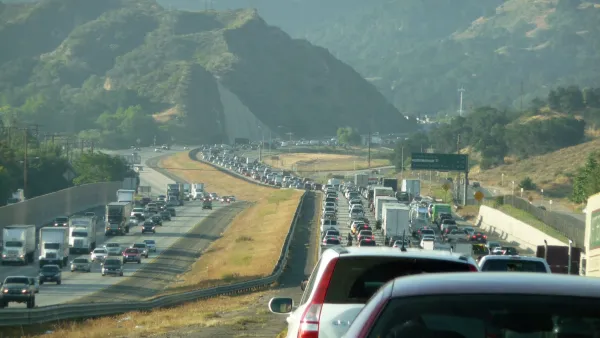New data released by the Federal Highway Administration shows that vehicle mile traveled increased three percent for the first nine months of 2016 compared to the same period last year. Driving has increased continuously since April 2014.

"The new data, published in FHWA’s latest 'Traffic Volume Trends' report – a monthly estimate of U.S. road travel — show that more than 265.5 billion miles were driven in September 2016 alone which is a 2.9 percent increase over the previous September," reports Doug Hecox for the Federal Highway Administration.
When seasonally-adjusted ("which is conducted by USDOT’s Bureau of Transportation Statistics as a way to even out seasonal variation in travel and enable vehicle miles travelled comparisons with any other month in any year"), the September increase drops to 2.4 percent. The adjusted increase over August 2016 was .4 percent.
The September 2016 Traffic Volume Trends report includes a map and chart showing the changes by regions. All five regions saw increases, with the West experiencing the largest at 5.5 percent, and the North-East and North-Central increasing the least, at 1.7 percent and 1.6 percent, respectively.
Vehicle miles travel increase and population growth
Planning agencies might set a goal of keeping VMT increase to a percentage of population growth, bearing in mind that the population would need to be adjusted for those who are at least 16 years of age. The American Public Transit Association points out in a 2009 report [PDF] that "from 1970 to 2007, VMT grew by 168 percent while population only grew by 48 percent," or 3.5 times as fast. That's slower than the first nine months of the year: VMT grew almost four times faster than total (unadjusted) population growth (about .77 percent).
Ideally metropolitan regions could replicate the smart growth policies enacted by Vancouver, B.C., which increased population while reducing traffic, as noted by Streetsblog USA's Angie Schmitt in 2013.
See the Planetizen post on driving totals for the first six months of 2016, which had increased 3.3 percent. A March post and blog indicate that 2015 broke what was thought to be "peak driving" record set in 2007. A January 2015 post noted that the increase in VMT in 2014.
FULL STORY: U.S. Drivers Log 2.4 Trillion Miles In First Nine Months of 2016

Analysis: Cybertruck Fatality Rate Far Exceeds That of Ford Pinto
The Tesla Cybertruck was recalled seven times last year.

National Parks Layoffs Will Cause Communities to Lose Billions
Thousands of essential park workers were laid off this week, just before the busy spring break season.

Retro-silient?: America’s First “Eco-burb,” The Woodlands Turns 50
A master-planned community north of Houston offers lessons on green infrastructure and resilient design, but falls short of its founder’s lofty affordability and walkability goals.

Test News Post 1
This is a summary

Analysis: Cybertruck Fatality Rate Far Exceeds That of Ford Pinto
The Tesla Cybertruck was recalled seven times last year.

Test News Headline 46
Test for the image on the front page.
Urban Design for Planners 1: Software Tools
This six-course series explores essential urban design concepts using open source software and equips planners with the tools they need to participate fully in the urban design process.
Planning for Universal Design
Learn the tools for implementing Universal Design in planning regulations.
EMC Planning Group, Inc.
Planetizen
Planetizen
Mpact (formerly Rail~Volution)
Great Falls Development Authority, Inc.
HUDs Office of Policy Development and Research
NYU Wagner Graduate School of Public Service




























